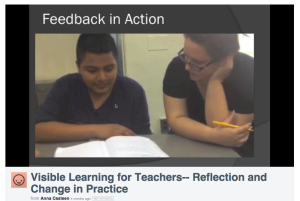Opening Classrooms with Teacher-Led Learning Communities

As we wrote earlier this year, “Among the many challenges facing us in education one of our most formidable foes is the comprehension gap, across all content areas, between students of low socioeconomic status and those of high socioeconomic status.” The multi-year project Opening Classrooms to Close the Knowledge Gap‘s goal was to enhance students’ ability to develop literacy across the diverse content areas. In the first post, we shared how teachers at School for the Future in New York City had addressed students’ ability to work autonomously through Peer Assistance and Review seminars that took place after school.
In this post, we’ll look at how the project worked to build a school wide culture of Teacher-Led Professional Learning Communities.
A professional study group around lesson analysis
To support the goal of building this teacher-led culture, School for the Future teachers engaged in a professional study group around a shared text, John Hattie’s Visible Learning for Teachers. This book challenged their thinking and pushed the teachers into incorporating many of the exercises into their own coursework. A specific example from the book gave instructors a simple three-step process to analyze their own lessons by looking specifically at the learning intentions.
- What is the outcome I am tracking progress toward?
- How do I track progress toward that outcome?
- How do students track progress toward that outcome?
In establishing the learning intentions the teachers looked at two things; skills necessary for participation in a democratic society and skills necessary for success in secondary and post secondary school.
Improving feedback on persuasive writing
What did teachers choose to focus on? Persuasive writing.

Although the teachers understood the need to zero in on writing performance, the students were somewhat harder to reach. To assist, teachers established another simple method of tracking student progress that included a common rubric that was used on every persuasive writing task and an online grading platform accessible to students, teachers, and parents.
Every participant teacher constructed a video that encapsulated how participating in the study group enhanced their professional practice. During the first year, only 11th and 12th grade teachers participated while in the second year it was expanded to include 9th and 10th grade teachers.
After the first year each of the participating instructors constructed a video encapsulating what they gained from participation and how the study group improved their professional practice. In this example, Scott Chesler, Inclusion Teacher, explains the impact of the teacher led professional development community.
In the videos teachers spoke how the group led them to alter how they gave feedback to students, leading the students to get to know more about themselves as writers. Teachers noted in their annual report that they are attempting this change from the bottom up rather than the top down. For example, teachers like Stephanie Van Duinen (9th grade social studies) asked students for feedback about the course and then analyzed the information. When she learned that a signifigant group of students needed more feedback, she worked with her professional learning community members to form an action plan for providing “in the moment feedback” so that students could use the information to improve their work as soon as possible.
This was a highly rewarding experience as it forced me to reexamine my beliefs about my own personal practice and think not so much about my methods of teaching but about their effectiveness.
-Stephanie Van Duinen, 9th Grade Social Studies Teacher
School of the Future, Manhatten, NY
One teacher reported that the course helped him realize that student expectations have a high effect on performance so he reimagined his course to track individual student goals, regularly meeting with the students as he coached them forward. Jessica Candlin, 11th Grade English Teacher, presented how she used commenting features in Google Docs to support enhanced feedback for student writing in the slides below.
Teacher-led collaboration creates powerful connections
Although there was a certain amount of trepidation when new teachers were introduced into the program during the second year, the collaboration ultimately led to powerful connections between educators. Teachers reported they could have started earlier in the year to complete the project. While it seemed like March would be an ideal start time, as most teachers have “settled” into their schedules, it made it difficult for them to get their video materials together in time for the deadline. In the future, the teacher led professional learning community will be able to draw on the important learning experiences from this project and continue making an impact on student literacy.
Learn more
Explore the following articles about teacher-led learning communities to learn more.
- Redefining Professional Development as Teacher-Led Professional Learning – NWEA 2013
- Teachers, Learners, Leaders – ASTD 2010
- When Teachers are the Experts – Education Week 2009

